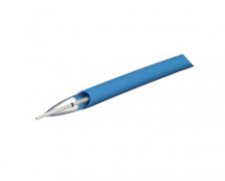
Categorised under:
Interventional Radiology
>
Uroradiology
>
PCNL dilators
The NephroMax balloon is marketed for dilating percutaneous renal tracts to allow percutaneous nephrolithotomy (PCNL).The package contains a 12cm length, 10mm diameter high pressure balloon (17ATM) mounted on a 55cm 7F shaft and with a 30F beveled plastic sheath pre-loaded. A calibrated inflation device and high pressure stopcock are also included.
The NephroMax balloon is marketed for dilating percutaneous renal tracts to allow percutaneous nephrolithotomy (PCNL). The package contains a 12cm length, 10mm diameter high pressure balloon (17ATM) mounted on a 55cm 7F shaft and with a 30F beveled plastic sheath pre-loaded. A calibrated inflation device and high pressure stopcock are also included.
Being little more than a large angioplasty balloon, the device is simple and intuitive in use. Once stiff guidewire access to the ureter has been achieved via a suitable calyx I usually pass a 7F sheath into the proximal ureter to allow passage of a second parallel “safety” wire, typically a Bentson, as insurance against later sheath dislodgement. The NephroMax tracks easily over the stiff wire through this tract but the usual care is required to ensure precise positioning, particularly in narrow infundibula as there is a degree of “nosecone” effect, ie the inflated balloon extends a few mm beyond the markers. Once full inflation has been confirmed fluoroscopically the 30F sheath can be advanced over the balloon until adequate positioning in the calyx has been achieved. The balloon deflates into a flattened, partially crimped configuration and is easily re-used if a further inflation or second tract is required.
Against metallic co-axial dilators the NephroMax has the chief advantage of speed with consequent reductions in procedural time and radiation dose, particularly to the operator’s fingers. Theoretically,as renal tissue is merely compressed by the balloon less parenchymal damage results than from metallic dilators and there is less opportunity to traumatise and kink the safety wire. I am unaware of good data showing differences in blood loss or other clinical parameters (including the incidence of repetitive strain injuries in operators!). Use of disposable balloons eliminates issues regarding reusable instrument sterilization if institutions have only small stocks of metallic dilators but a sudden glut of stones to remove.
Balloon dilatation of tracts is difficult when dilating onto a large calyceal stone as room beyond the desired tract is necessary for adequate inflation and for these cases I feel metallic co-axial dilators still have a role to play. A further alternative, also marketed by Boston Scientific, is the Amplatz Graduated Renal Dilatation Set, consisting of a stylet, twelve serial (not co-axial) plastic dilators (8F to 30F) and four bevelled plastic sheaths (24F to 30F). This equipment has two disadvantages. Firstly each plastic dilator must be removed in order to pass the next, leaving the tract exposed and bleeding during transition. Secondly the nosecones on the plastic dilators lead to the same difficulties as the NephroMax with precise dilatation onto a large calyceal stone.
The NephroMax is an excellent device for the majority of PCNL access but a set of metallic co-axial dilators is a useful adjunct for certain cases.
No conflict.
Dr Dominic Fay
Consultant Interventional Radiologist
Royal United Hospitals, Bath, UK

Did you know you can Register for FREE with this website?
Registration gives you full access to all of the features of WhichMedicalDevice. Find out more ...
WhichMedicalDevice is a FREE resource created by clinicians for clinicians.
Registration is free and gives you unlimited access to all of the content and features of this website.
Find out more...Registration is free and gives you unlimited access to all of the content and features of Which Medical Device. Find out more...
Which Medical Device is a community of clinicians sharing knowledge and experience of the devices and procedures we use on a daily basis. We ask that our members register with us so that we can maintain the unbiased and independent nature of our content. Registration is quick and free.
We do not make your details available to any third parties nor do we send unsolicited emails to our members. You can read our Privacy Policy here.